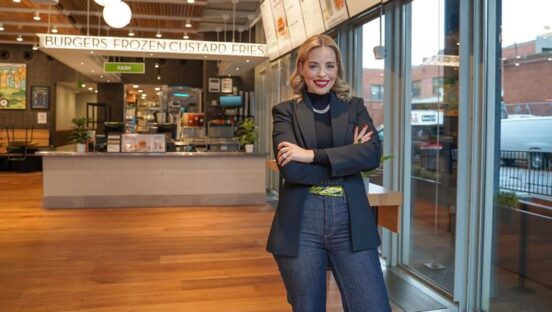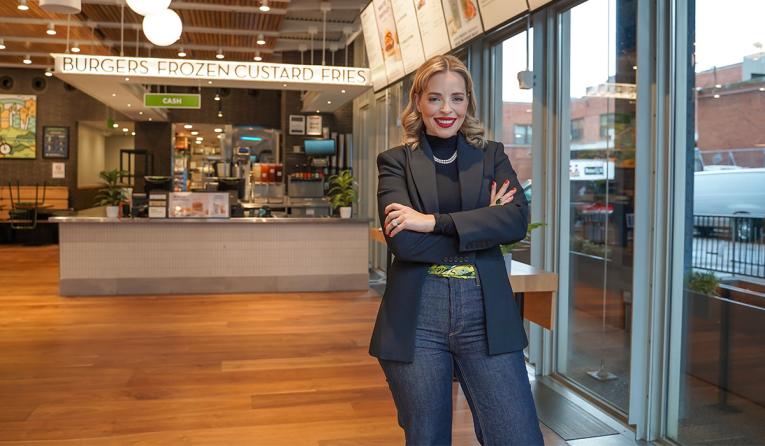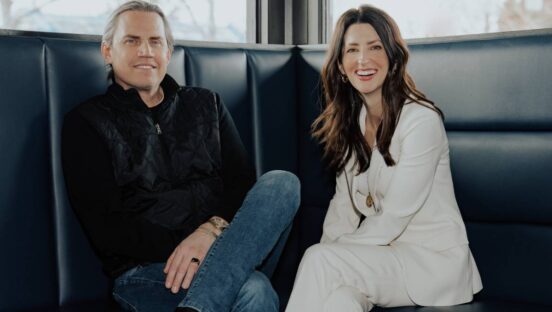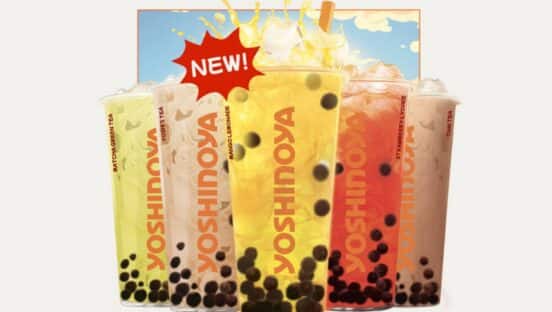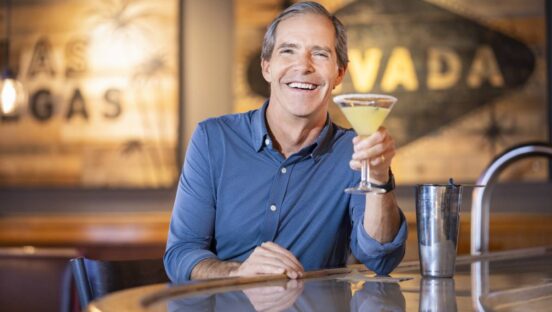Katie Fogertey was already well known within Shake Shack circles. As Goldman Sachs’ lead analyst covering restaurants, she wrote a bull report for the fast casual during a time when few pundits agreed. How investors saw the company, Fogertey felt, wasn’t reflective of Shake Shack’s unicorn position among quick-serves, or its growth potential.
There were 297 systemwide Shacks at this time—end of Q2 2019. Today, there’s more than 430.
Going back, Fogertey held a number of “big conversations,” she says, about how she came to that conviction and buy rating. It earned her a measure of notoriety. But soon enough, Fogertey was having an entirely different discussion around Shake Shack’s prospects.
When COVID-19 arrived (good luck trying to model sales), Fogertey decided she wanted to get off the sidelines. “I wanted to be part of the solution and the path forward,” she says. “It felt like it was just something that was inside of me.”
Shake Shack’s chief financial officer positioned opened and Fogertey told her husband, “That’s the job I want.”
She called the next day and pitched herself.
For a brand founded in 2004 as a hot dog cart to benefit New York City’s Madison Square Park, spearheaded by hospitality guru Danny Meyer, Shake Shack has never quite operated within fast-food convention. Its original openings catered toward younger consumers and a vibe inclusive of a changing generation. The food took longer to come out. Quality, ethos, and experience were placed out front from the initial step to the first bite.
READ MORE: A Conversation with Shake Shack CFO Katie Fogertey
So the idea of tapping a CFO who had spent more than 15 years at Goldman Sachs and wasn’t carousel-ing around the industry C-suite ranks, fit Shake Shack’s disruptor DNA. “I have this very different background than others do, but coming in and them really embracing my ability to—and my desire—to statistically model out sales in a company that, frankly, is not very well understood by investors, there’s a lot of different drivers out there,” says Fogertey, who has a bachelor’s degree of business administration in accounting, finance, and international business from Washington University in St. Louis (Meyer’s hometown, fittingly). “It’s been really exciting.”
And perhaps it was destined. Fogertey was a colicky baby growing up in St. Louis. The only song that calmed her? Frank Sinatra’s “New York, New York.” She came up to the Big Apple in high school for an internship, took a college course at The New School, and knew exactly where she’d move when she got the chance.
Now, stepping into the CFO role in June of 2021, New York City—and Shake Shake—had a COVID crater to climb out of. The brand’s average weekly sales sunk to $32,000 out of the pandemic gates, in April 2020. They were now up $69,000. It was a fast evolution. If you took all 126 locations in the company’s comp base at the time and removed the bottom 25 performers, the brand’s same-store sales in April 2021 improved from negative 15 percent to just under 3 percent. Simply, the urban footprint presented major challenges. Its Theater District and Herald Square locations—two of the busiest stores ever opened—were fractions of themselves. Shake Shack’s Grand Central unit remained closed. Q1 comp sales, year-over-year, were up 5.7 percent overall; in April, they boomed 86 percent off the pandemic floor.
“Thinking about the long-term growth trajectory, what we’re doing every day is not just providing great experiences,” Fogertey says. “We’re really building up our people from the ground up.”
However, to get a sense of the full picture Fogertey took her skillset to, Shake Shack’s April performance was 15 percent lower than 2019 as suburban stores were flat. The brand hadn’t quite yet recovered.
Meanwhile, an interesting dynamic was taking shape industry-wide.
By mid-May 2020, 25 of the largest public restaurant chains more than doubled aggregator cash holdings, from $9.4 billion pre-pandemic to nearly $20 billion, according to financial services company Rabobank. All of them carried more cash suddenly than pre-virus.
Shake Shack was definitely one of those. CEO Randy Garutti described the industry’s stock-piling as a “moment where no company was unsinkable.”
Shake Shack conducted an equity transaction and brought in a significant sum. The brand saw the convertible debt market reach “incredible opportunities,” Garruti said, and issue debt for $250 million at a zero percent coupon for seven years. As Garruti noted, “we may never see numbers like that in our lifetime.”
The result was Shake Shack fortressed its balance sheet in a way it never had before. Come May 2021, the brand had more than $400 million in cash. In Baird analyst David Tarantino’s words, it represented “probably more than [Shake Shack will] ever need to grow the business.”
Yet it was impossible for Tarantino, or any analyst for that matter, to guess just what Fogertey and Shake Shack had in store.
Deep impact
“They needed somebody who had a very strategic mindset,” Fogertey says of those early days on the job. “Having your classic CFO who might not be as strategic minded wasn’t going to do anybody any favors.”
Sure, Shake Shack could use more support and rigor in defining its finance function overall. But when Fogertey looked at the wider opportunity, there were ample places her forward-thinking vision could be levered at Shake Shack. She jumped into stores and spent weeks working with employees. “Getting to understand the company,” Fogertey says, “from soup to nuts.”
It was clear to Fogertey Shake Shack’s culture was its launch pad. “Thinking about the long-term growth trajectory, what we’re doing every day is not just providing great experiences,” she says. “We’re really building up our people from the ground up.”
We’ll get more into the labor side of Shake Shack later, but the operational transformation locked into place quickly. The brand’s omnichannel efforts predated COVID, as was the case for a plethora of quick-serves. However, the gravity of digital infrastructure was muted in comparison, to put it lightly. In addition to the chain’s heavy urban base, one of the reasons Shake Shack’s battle out the pandemic trough was so steep owed to many of its differentiators. The brand debuted as a social, hospitality-forward concept that encouraged guests to stick around. It wasn’t as transactional as some of its peers, or as streamlined across channels—core traits you might expect from a fast casual founded by a Michelin-starred restaurateur.
That urban drag coupled with a lack of drive-thrus plunged Shake Shack’s U.S. sales as much as 90 percent at some U.S. venues in the opening COVID weeks. The average of 70 percent felt closer to full-service counterparts than counter-service ones.
Shake Shack is targeting drive-thru economics of $4 million-plus average-unit volumes, $2.4–$3 million build costs, and store-level operating profit margin on par or better than company averages.
Beyond an easing in regulations and improved mobility as recovery progressed, Shake Shack turned course by finding its customers. And few have done it better. In March 2020, digital sales mixed 23 percent of the business. That climbed to 81 percent by May and settled to 59–62 percent by the final six months of 2020.
Of late, much of the chain’s gains result from in-store dining flooding back. People want to hang out in Shake Shacks again. And yet, this increased foot traffic layering on top of “digital channels that never existed a few years ago,” Garutti said in December, pushing the brand to optimistic heights. Shake Shack’s total revenue in Q4 rose 17.4 percent, year-over-year, to $238.5 million as same-store sales upped 5.1 percent.
Shake Shack’s future unfolds across new, dynamic buckets—the expansion of its delivery services, kiosk, digital, drive-thru, and multiple format investments. The total addressable market for Shake Shack today versus 2019, frankly, isn’t comparable.
Digital and kiosk sales are up 330 percent since 2019, from $147 million to $494 million. Digital guests spend 20 percent more than traditional ones. They boast higher frequency and offer Shake Shack access to new occasions.
Fogertey refers to the movement as “migrating people into the omnichannel.”
“We want to make sure what we’re seeing is that they might be coming to the app sometimes, they might be coming into the Shack at other times, and we want to meet them wherever they are,” she says.
For Shake Shack, this meant leveraging and improving what was already built to provide a compelling guest experience. In Q3 of fiscal 2022, Shake Shack ballooned its digital app purchasers by 40 percent, year-over-year (more than a million app installs since the beginning of the calendar). From March 2022 forward, it gathered more than 4.5 million unique first-time digital app purchasers, feeding the base with offers like giving digital users first access to LTOs. Shake Shack’s digital guests spent, on average, 25 percent more per visit than non-digital users that quarter, and digital mix was 36 percent of sales.
Switching lanes, Shake Shack launched direct delivery in March 21—a decision that triggered a 70 percent increase in delivery order volume through its app in one year. Also, going native allowed Shake Shack to put its best brand foot forward. “Our strategy in the delivery wars is to own the guest ordering, regardless of pickup or delivery mode, and ensure our guests have a uniquely Shake Shack experience, even if they order delivery and never walk into our Shack. The guest ordering experience is the best presentation of our full menu—we highlight imagery, descriptions and modifications in a way that provides the optimal guest experience,” says Steph So, head of digital experience. “While third-party apps offer a wide range of restaurant choices and are a great way for guests to try Shake Shack the first time, they create a ‘sea of sameness’ with the number of restaurants surfaced to a user, and our unique brand voice and interactions are not able to shine through. We also want to offer our guests the best value, which we can control most directly on our channels, and be transparent with fees.”
Shake Shack first piloted nationwide delivery via its iOS app in New York City and Miami. It then rolled nationwide as part of an exclusive deal with Uber Eats. That’s when the jump in delivery order volume took shape and led Shake Shack to plant firmer roots. The brand built out its technology development team in collaboration with Uber Eats fulfillment, allowing for more direct contact with guests, So says, and “ensuring the ultimate, frictionless experience.” Alongside, Shake Shack launched a mobile-first web redesign and introduced delivery in the Android Shake app as well as new payment options, including Apple Pay, Google Pay, and contactless options. The overall value proposition was a lure, too. “Our app menu is our lowest price menu compared to all nationwide delivery apps, and we don’t require subscription fees to access our low delivery fees,” So says. Fees don’t change, there’s no surge pricing, or menu markups. Shake Shack is rewarding direct guests in an effort to bolster its base and get personal. “We’ll regionalize their experience and target offers based on their behavior, which we cannot see if guests are ordering via third party,” So says.
For instance, if a guest is based in New York City, Shake Shack can share local events and relevant news, everything from chef collaborations, events, and new openings.
Getting physical
Returning to the point of in-store traffic, this might be where Shake Shack is most visibly evolving—inside and outside. Starting with the former, the brand in November committed to retrofitting all locations with kiosks by the end of 2023. At that point, roughly half of units had them. Fogertey says kiosks “are a really important part of our story right now,” and it’s easy to grasp where she’s coming from. On paper, they’re a great return on capital. You can put four to five-plus in each location and take out cash registers (there will always be at least one of those, Fogertey says, for guests who use cash or for the sake of alcohol purchases). The brand can redirect labor within stores and appreciate a nice lift on ticket sales given how superior the merchandising is. “We’re selling more LTOs,” Fogertey says. “We have more of a higher premium attach rate on those [kiosk] channels.”
Spun another way, kiosks empower Shake Shack to optimize labor to other parts of its guest journey. They provide operators flexibility during peak traffic and staffing challenges.
Additionally, kiosks represent Shake Shack’s highest-margin channel, which doesn’t hurt, either. In restaurants where it has kiosks, about 75 percent of sales flow through kiosk and digital channels. As noted, digital plus kiosk mix 57 percent of total sales today for Shake Shack. In 2019, the figure was 26 percent. “We have the ‘Stand For Something Good [mantra],’” Fogertey says. “We’re hopeful the kiosks will make you stand not as long for something good.”
Shake Shack doesn’t generally lack for buzz. One trip to the Times Square store and the boisterous lines that wrap around, will prove that. But the reality is Shake Shack remains a brand relatively young in its growth journey.
Back in January 2020, ahead of the crisis, 60 percent of the burger chain’s domestic units were less than 3 years old. Twenty-four percent had been on the market for 12 months or less. The average age of restaurants across 163 U.S. corporate venues was 2.9 years. Twenty-three of Shake Shack’s 31 markets at the time boasted five or fewer locations. And this isn’t even getting into the global and licensing picture (the brand ended 2022 with 182 licensed Shacks and expects 25–30 openings in 2023).
The 430-plus global locations today cover 32 states, plus Washington, D.C., and 16 countries. Shake Shack opened 36 new domestic corporate stores last fiscal year, 22 of which landed in Q3. It debuted 33 licensed Shacks, 13 in the final period. There are 23 airport Shakes open worldwide; four roadside travel plaza spots, with three to five more on deck for this year. Ahead as well is Shake Shack’s first licensed opening with a resort partner in the Bahamas, at the Atlantis Resort.
In all, Shake Shack’s roadmap has a vast Atlas in front of it. Fogertey says the kiosks play a key role here as well, given they visually lay out the brand’s differentiators from the outset. What makes Shake Shack’s menu unique? Guests can see instead of read it.
A recent note from Fogertey’s past shop in Goldman Sachs expressed excitement over the brand’s “diversification of store formats and think this will be key in driving unit growth for the company.”
This sentiment, as much as any, illuminates Shake Shack’s promise. COVID and all of its disruption, as well as the brand’s relatively small footprint compared to its overall projection, means the future is rife for innovation.
The fast casual launched “Shack Track” at the start of the pandemic in response to the digital boom. “Many of the fast pivots in the early days of the pandemic soon became permanent functions,” Fogertey says. And this included implementing multi-channel delivery, enhancing digital pre-ordering, and expanding Shake Shack’s fulfillment capabilities. Shack Track, dressed down, is the brand’s digital pre-ordering and fulfillment experience. It manifests across pickup shelves, curbside pickup, pickup windows, and more. The need to enhance the physical restaurant to meet the needs of digital was so important to Shake Shack, Fogertey says, that all new restaurants the company opens now have some aspect of Shack Track.
A resounding illustration is Shake Shack’s drive-thrus. There were 11 open to start 2023, nine of which arrived in 2022. Ten to 15 more are expected for 2023.
Shake Shack is targeting drive-thru economics of $4 million-plus average-unit volumes, $2.4–$3 million build costs, and store-level operating profit margin on par or better than company averages. The higher development cost of drive-thrus, coupled with inflationary pressures, drove Shake Shack’s 2022 class up about 15 percent, year-over-year. Last year, total Shack net build costs were an estimated $2.4 million, above the historical $2–2.1 million.
Garutti, however, wasn’t fazed. “Some of the best sites we’ve ever had will be there for decades to come because we chose to invest. That’s how we’re thinking about drive-thru,” he said in January.
Shake Shack generally grows across three buckets: the standard that’s been erected hundreds of times at around $2 million; small-format units under 3,000 square feet that target dense urban environments, food courts, and higher traffic suburban locations (this is where the nontraditional business is unfolding); and now, drive-thrus.
What’s intriguing about the drive-thru is how it’s enabled Shake Shack to rethink its market density. Since 2021, the company opened two stores in Orlando less than a mile apart—a drive-thru in Vineland Pointe and a food court in Orlando Premium Outlets. The drive-thru served an audience where 45 percent of guests were local, living within 10 miles. It generated $86,000 in average weekly sales and $4.5 AUV. The location recorded about 20 percent store-level operating profit margin in Q4 as well.
The food court spot, however, greeted less than 15 percent of guests who lived within that same radius. Still, the store turned in average-weekly sales of $75,000 and $3.9 million AUV. Operating profit margin was 35 percent.
Simply, having a drive-thru format in the arsenal offered Shake Shack the chance to serve a new guest and increase the sales opportunity for a small target area. It’s representative, Fogertey says, of how the brand views ultimate market expansion as it right-sizes formats to each location.
The final calculation: Shake Shack pulled $8.5 million of sales in less than a mile.
Fogertey adds the roadside angle is one that shouldn’t be slept on. They’ve given Shake Shack another chance to steamroll the status quo. “People are so excited when they’re going to the Jersey Shore, or wherever they’re going, and they stop and they say, ‘oh my gosh, I can eat at Shake Shack here?’” she says. “The lines at these places are really, really big, and we’re just providing them an elevated experience that they wouldn’t be able to get otherwise.”
One of Fogertey’s first decisions as CFO was to set up a business intelligence unit so Shake Shack could study and analyze factors driving success, not just in sales, but also in real estate. “That’s just an important element, baseline, for scale,” she says.
The result is what you’re seeing across all of these designs—a deliberate, data-driven approach to fitting Shake Shack where it wants to expand. And when the brand gets there, it’s going to deploy customer relationships and tools, like kiosks, to get the message across.
“We’re going to be leaning on those kinds of things that make us truly differentiated and special,” she says, referencing the brand’s premium, no hormone, no antibiotic products and culinary spins, like white truffle, “because I think that’s the key to continuing to grow our sales. And make sure we stay relevant and that consumers keep us in their mindset.
Building from within
Shake Shack raised its starting wages more than 20 percent since 2019. The company earned a 100 percent score on Human Rights Campaign’s Corporate Equality Index (fourth straight year) and hosted a biannual leadership retreat in May to develop more than 1,000 employees. This past year, 52 percent of overall hires were women; 81 percent people of color. Fifty-five percent of promotions were women and 77 percent people of color.
Over the past couple of years, Shake Shack expanded its Shift Up platform, which is a leadership development initiative that provides shift managers with tools to advance to managers. The brand doubled the number of graduates from the ongoing cohort. Additionally, GMs are offered equity grants.
There’s a lot going on behind the curtain, Fogertey says.
On a granular level, the brand offers about $15 per hour as an average national starting wage and invests in diversity and inclusion in part through a formal program called, “All In,” which housed Shake Shack’s “Stand Together Series in June 2020.” The online platform enabled employees to share stories and included 36 independent speakers at all levels. More than 2,000 people participated as the company addressed social issues and broader themes, such as how to overcome dependencies and racial issues. Shift Up is a pillar of All In. Employees asked for a more defined career ladder and the skills to climb it, so Shake Shack invented the 18-week paid development option with the goal of eventual promotion within Shake Shack’s corporate structure.
Shake Shack recently expanded benefits to include mental health resources and now provides access to an Employee Assistance Program (eap) to the entire company upon hire. Shake Shack also continues to explore alternatives to a traditional workweek. Throughout 2018 and 2019, it launched and piloted a four-day setup in select stores. It’s currently testing with hourly employees and managers along the West Coast.
All of these efforts, Fogertey said, are what struck her most coming over. “The thought of what Shake Shack was from the outside looking in, you think about this great growth opportunity, you think of amazing burgers, amazing shakes, and everything, but when you’re there, and you see the magic of how this company really supports its people,” she says, “that’s eye-opening.”

